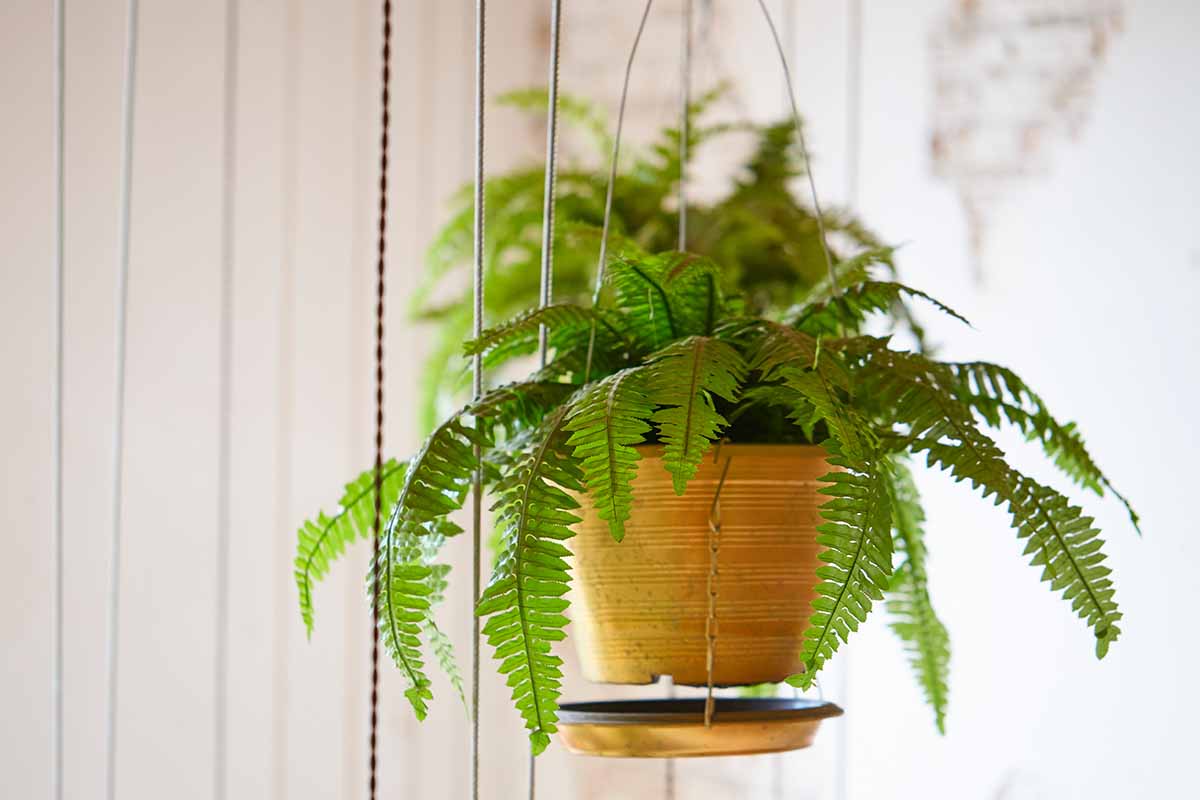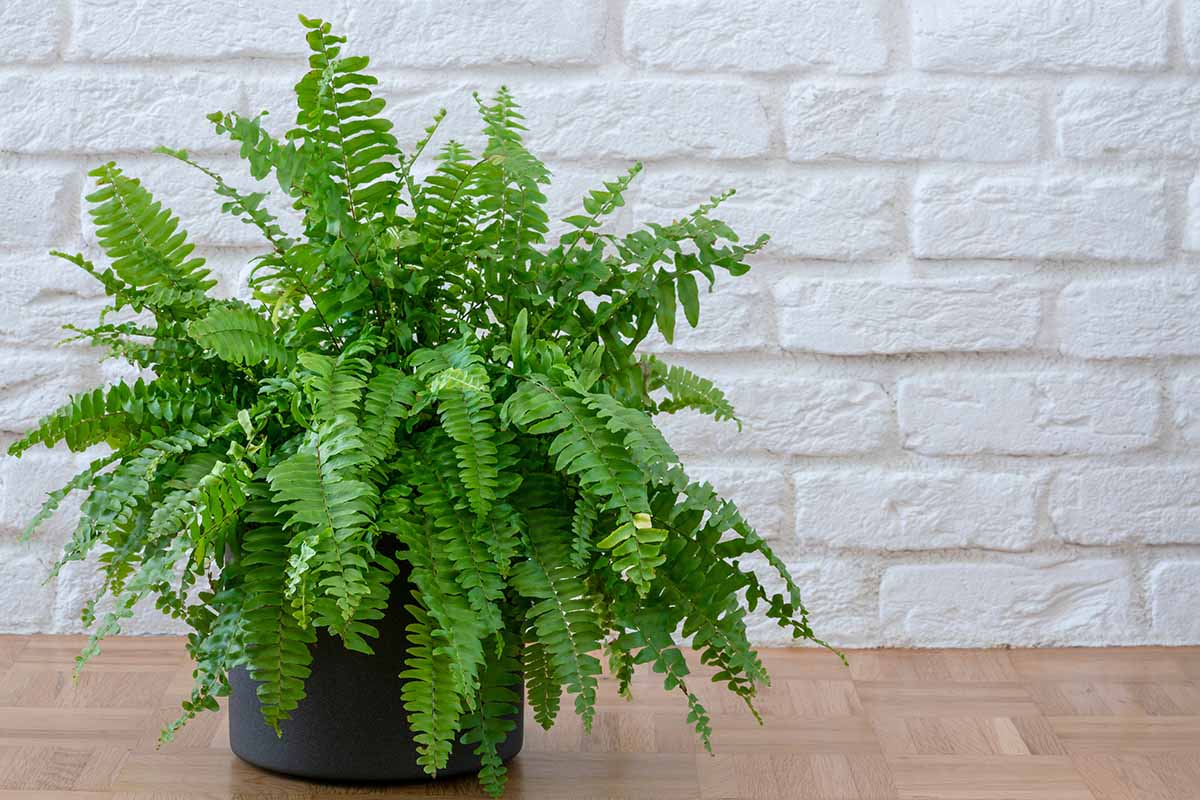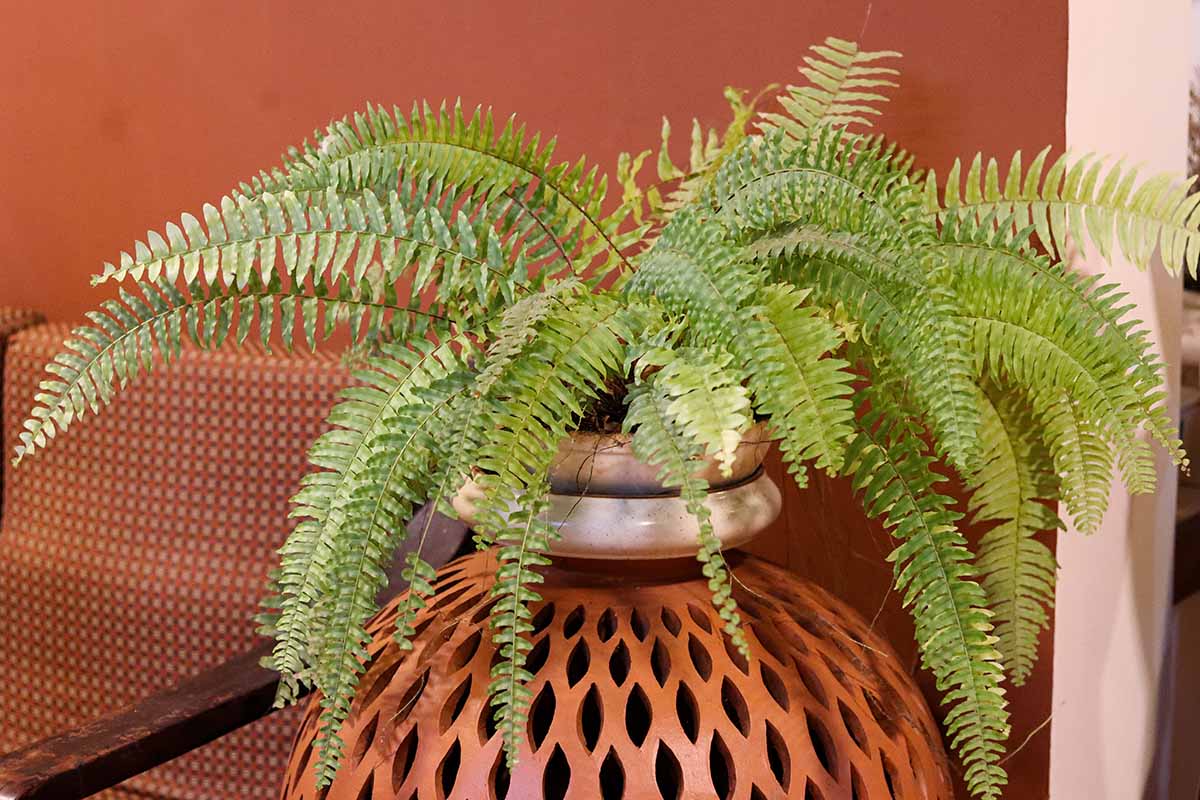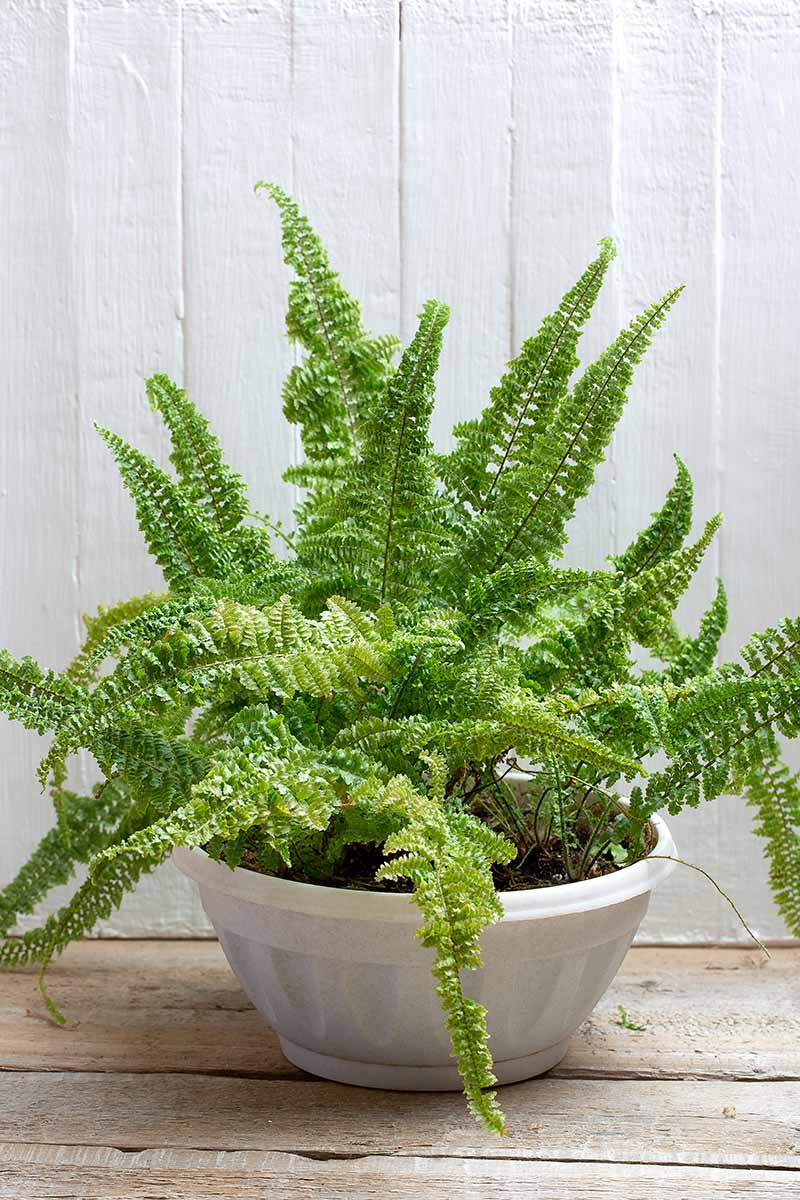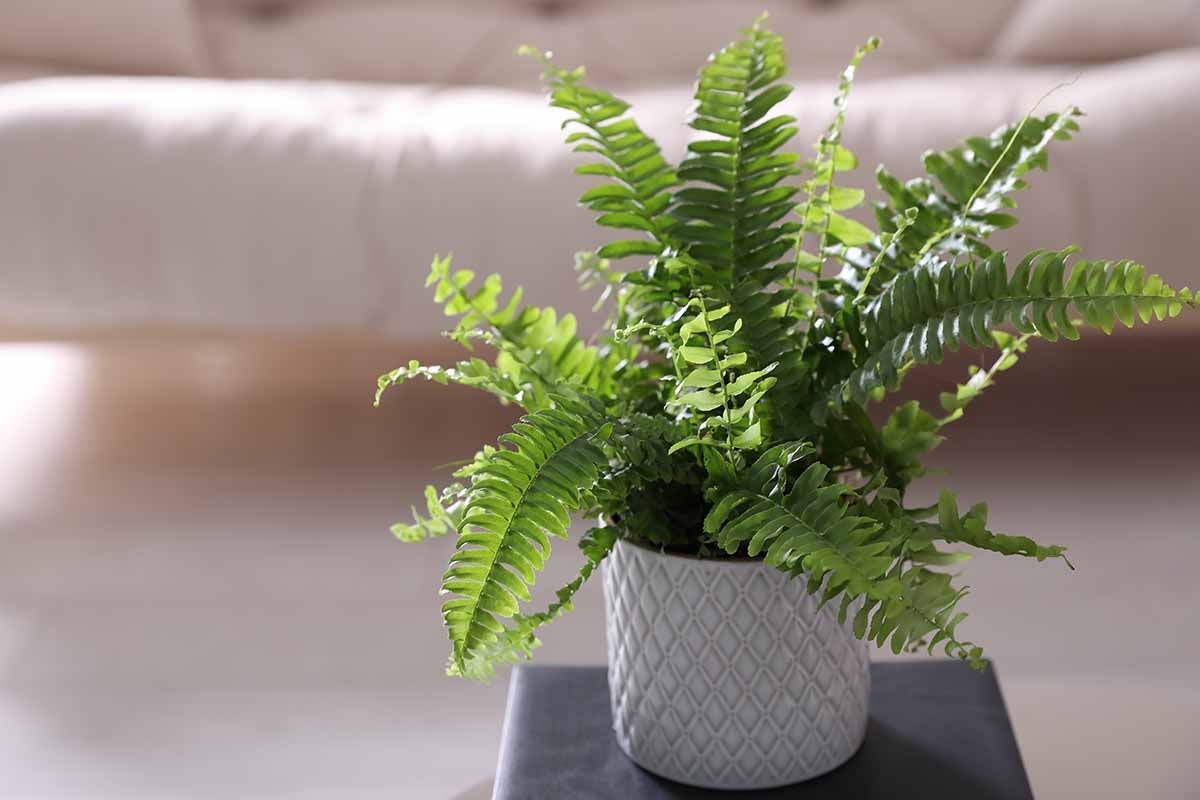But every Boston fern owner – or plant parent, for that matter – faces the same annual trial if they live in a region with cold, frost-filled winters. It’s that time when growth slows down considerably, some fronds start to brown, and the plant as a whole can get kinda sad-looking… especially compared to its heyday back in the growing season. We link to vendors to help you find relevant products. If you buy from one of our links, we may earn a commission. Yes, it’s a bit unpleasant now, but once it’s warmer out, dormancy will be a distant memory. During this overwintering period, there are some actions that a green thumb can take to keep this plant healthy, along with priming it for eventual re-growth once spring starts. Additionally, wintertime N. exaltata cultivation needs will change somewhat, in ways that every gardener should be aware of. In this guide, we’ll cover the hows and whys of overwintering a Boston fern, along with some items that you’ll need throughout the whole process. Feel free to give the itinerary a quick look-see:
Benefits of Proper Overwintering
There are advantages to overwintering the right way, as opposed to simply winging it.
Cost
Plants ain’t cheap, so having to purchase new flora to replace those that died during the winter would make anyone’s wallet feel a bit light. By overwintering, you can continue to grow the same perennial specimen year after year!
Aesthetics
An N. exaltata won’t look its best during the winter, but when properly overwintered by following recommended care practices, it’ll survive to see the return of spring, and it will look much better than one that’s completely left alone.
Health and Vigor
N. exaltata foliage will most likely start to brown in winter when grown outdoors in regions that are hit by frost, and these decaying fronds are alluring entry points for pests and pathogens. By snipping these weak spots when you see them, infestations and infections are less likely to occur. Additionally, a Boston fern that’s overwintered properly will be optimally primed for vibrant regrowth come spring!
Longevity
A pretty obvious advantage, but it’s one that’s definitely worth stating. Winter is a vulnerable time for many plants, and if they’re not cared for and treated properly, the harsh conditions could easily kill them. This is true for both outdoor specimens and houseplants that remain indoors year round. Even though their environment hasn’t changed all that much, N. exaltata plants grown indoors don’t require as much sun, water, or nutrients in winter as they do during the growing season. So if you treat them the same in winter as you would in summer, you’ll be left with a sun-scorched, over-watered, and over-fertilized Boston fern… which is bad, obviously. Proper care techniques that change to adapt to the needs of your plants at different times of year can not only help them to look better during the growing season as described above, they can keep them going for many years. In all other Zones, ideally, you’ll want to bring an outdoor Boston fern indoors before temperatures start to consistently plunge below 45° F.
Hand Pruners
Essentially a heavy-duty pair of gardening scissors, hand pruners are necessary for snipping off brown and dying fronds. Bypass pruners in particular will provide the cleanest cuts possible. Bypass Pruners To purchase a set of ultra-sharp pruners that come in either sky blue or rose gold, visit Garrett Wade.
Garden Hose with Spray Nozzle
Before bringing a Boston fern inside, it’ll need a good shower water first. The best way that I’ve found for doing this is with a standard garden hose with a spray nozzle attachment. While you could put your thumb over the hose hole and manipulate the water pressure to create an improvised stream, such a spray is rather harsh on N. exaltata fronds. You’d be better off using a gentle “shower” setting instead on a nozzle designed for this purpose instead. Plants grown indoors year-round can also benefit from an occasional sprinkle that resembles gentle rain to remove dust and debris, but the goal here is also to remove any pests or pathogens that are clinging on before bringing them inside. Easy-Squeeze Spray Nozzle An easy-squeeze spray nozzle with seven different spray patterns is available from Gardener’s Supply. Water Right Hose And if your hose is in need of an upgrade, Gardener’s Supply offers 50-foot lengths of lightweight rubber in fetching shades of green, orange, and purple.
Humidity Tray
Boston ferns love humid conditions, and a great way to provide additional humidity is with a tray that’s filled with water and pebbles. As the water evaporates, it’ll increase the moisture in the air adjacent to the plant. Cheap, easy, and efficient. Landscaping Pebbles You can order all the pebbles that you need from The Home Depot. Alternatives include grouping houseplants in clusters to increase ambient humidity, spraying plants with a gentle mist of water, or running a humidifier in the vicinity.
Watering Can
N. exaltata doesn’t need quite as much water during the winter as it does during the growing season… but it definitely needs some. An ideal can for watering overwintered plants is well-balanced and compact, with a narrow spout for fitting past dense clumps of foliage. You can read about our top picks for watering houseplants in this roundup. Copper Indoor Watering Can I like this copper version, available from the good folks over at Gardener’s Supply.
How to Overwinter a Boston Fern
In USDA Hardiness Zones 9 to 11, Boston ferns can be grown outdoors year-round. During the dormant season, their need for supplemental irrigation and fertilization will be greatly reduced. In addition, you’ll want to cut your N. exaltata plantings down to the ground by the end of fall to reduce the incidence of overwintering pests and diseases, as well as eliminate ragged-looking winter foliage. If the fall weather in your area is erratic or inconsistent, keep a close eye on the forecast if you’re not yet prepared to bring your plants inside. You can cover your specimens with lightweight blankets or sheets on those anomalously cold days as long as you get outside in advance of the cold snap. Be sure to remove the coverings when temperatures warm in the morning. Before you bring your ferns inside, though, you’ll need to thoroughly spray down your plants with water first in order to knock any pests off of the tops and the bottoms of the fronds. After spraying, leave the plants out in the sun for a day to dry. A warmer day is going to be ideal for doing this, when the temperatures remain at or above at least 60° F. After this spray-and-dry process is complete, you’ll want to give your N. exaltata a quick pruning. First, remove any brown or damaged fronds. Then snip off any fronds that are significantly longer than average to create a pleasing shape. Cut fronds can easily fall into the mass of foliage, so give your plants a good ruffle or shake when you’re finished, just like the kind you’d give your own head after a haircut. You may need to utilize a weather app or website in order to schedule all of this out, and be sure to make a note in your gardening journal! Log the average dates when these temperatures and seasonal changes in the weather are likely to occur, and plan accordingly. If cool or cold temps occur sooner or later than anticipated, you may need to make some slight adjustments to your calendar – it’s best to be prepared! At this point, all of the ferns that you want to overwinter indoors should be taken inside, unless they’re grown year-round as houseplants. Location-wise, pick cool to moderately warm (60 to 75°F) locations in indirectly lit spots in or adjacent to your home such as garages, basements, or the corners of rooms. Keep the plants away from south-facing windows – the intense light could scorch the fronds. Place each N. exaltata on its own pebble-and-water-filled tray. For even more humidity, group plants close together so that their combined, adjacent evapotranspiration promotes a humid environment. Remember that indoor heating in the winter dries out the indoor environment. The irrigation needs of these plants throughout the winter are going to be lower than they were during the growing season, so only water the plants when the soil dries out completely. You can use your finger to test this, or try a moisture meter. Supplemental fertilization should be avoided throughout the winter. Your Boston ferns might drop some fronds or develop paler-looking foliage in the winter, and this is to be expected. For the most part, this is normal. But if it happens in excess, double-check and ensure that your environment is adequately lit, cool, and humid. When winter is over and temperatures start to hit and remain in the 60s on a regular basis, feel free to move your indoor Boston ferns to their usual spots inside, and bring the outdoor ones back outside to reacclimate. Just as you would if hardening off transplants, it’s best to bring them out for half an hour on the first day, an hour on the second, and so on, increasing the amount of time spent outside for another half an hour each day until they’ve fully adjusted and they’re able to rejoin your patio or garden. If the temperatures decide to drop out of nowhere, be prepared to bring your plants back inside until the weather warms consistently. If not, no worries! It’ll bounce back as long as the crown and roots are still alive, and you can chalk this up as a lesson learned for next year. There’s a true sense of satisfaction to re-establishing the same Boston fern in spring that you brought indoors the prior fall. You moved a plant, kept it safe, then re-integrated it back into its original home… I mean, how cool is that!? Any questions, relatable anecdotes, or random remarks can go into the comments section below. Sharing our personal experiences as gardeners helps the community as a whole become more knowledgeable, so don’t be shy! Your insight is very important to us! For more growing guides on our pteridophyte friends, have at these here articles next:
How to Grow and Care for FernsHow to Grow and Care for Heart FernsHow to Grow and Care for Autumn Ferns

